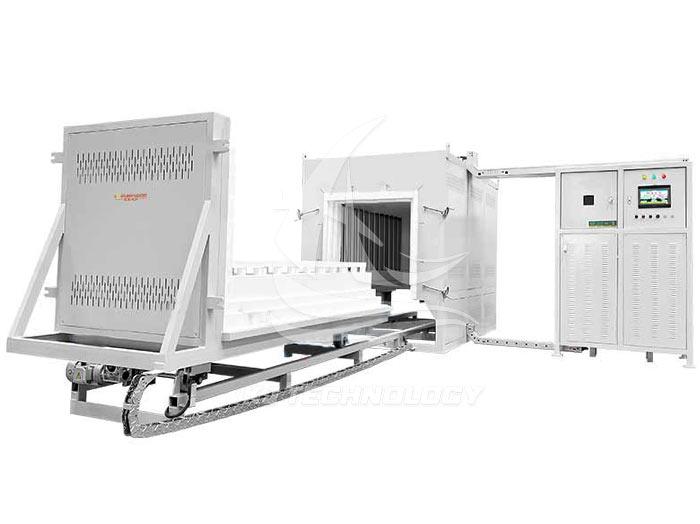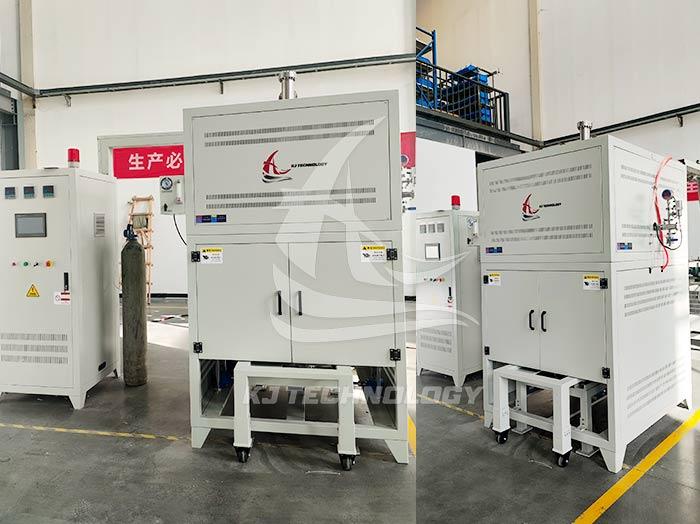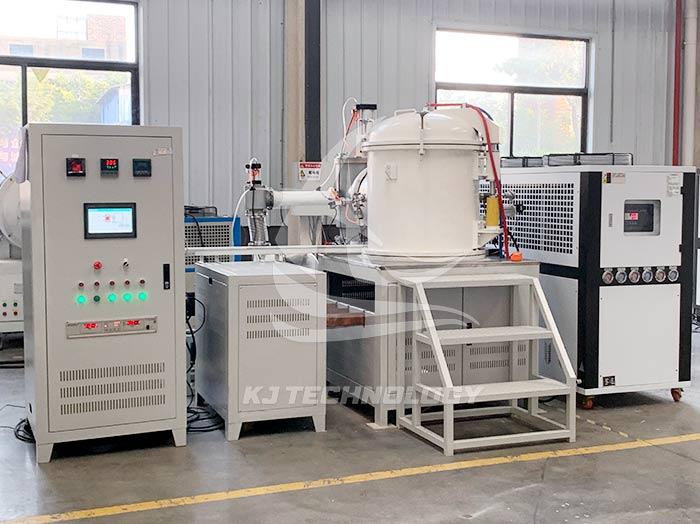Vertical graphite vacuum furnace
 09-03-2025 Author: KJ technology
09-03-2025 Author: KJ technology
Vertical graphite vacuum furnace: a powerful tool for material processing in high-temperature vacuum environments
1. Equipment definition and core principles
Vertical graphite vacuum furnace is a vertical high-temperature heat treatment equipment that uses graphite as the heating element and key structural material in a vacuum or inert gas environment. The core principle is based on the resistance characteristics of graphite: in a vacuum state, current flows through graphite resistors to generate heat, which is then transferred to the materials inside the furnace through thermal radiation, achieving processes such as high-temperature sintering, heat treatment, or graphitization. The vacuum environment significantly reduces heat conduction and convection losses by reducing the concentration of gas molecules, while suppressing material oxidation, ensuring the purity and efficiency of the processing.
2. Equipment structure and technical features
Furnace body design
Vertical structure: adopting a vertical layout, the furnace cover is opened through a lifting shaft, which facilitates material loading and furnace maintenance, especially suitable for processing long tube or layered materials.
Double layer water-cooled vacuum chamber: The furnace cover and body adopt a stainless steel double-layer sandwich wall structure, and the internal circulating cooling water effectively prevents the furnace shell from being deformed by heat, ensuring long-term stable operation of the equipment.
Multi layer insulation screen: a circular multi-layer structure composed of graphite and graphite felt, with high thermal conductivity graphite in the inner layer and low thermal conductivity graphite felt in the outer layer, minimizing heat loss and improving energy utilization efficiency.
heating system
Graphite heating element: including graphite rods, graphite tubes, etc., the resistance characteristics enable it to maintain stable heating efficiency at high temperatures, and the temperature uniformity can reach within ± 5 ℃.
Multi zone independent temperature control: The resistance furnace type can be divided into multiple heating zones, each equipped with independent temperature sensors and controllers to meet complex process requirements.
Vacuum and Atmosphere System
High vacuum degree: By combining a mechanical pump with a molecular pump, the vacuum degree can reach 10 ⁻³~10 ⁻² Pa, effectively suppressing material oxidation and removing impurities.
Inert gas protection: It can be filled with argon (Ar) or nitrogen (N ₂) to regulate the furnace pressure and assist heat transfer, especially suitable for oxygen sensitive processes such as lithium-ion battery negative electrode materials.
control system
PLC programming control: supports preset process parameters and automatic execution, with interlock protection function to prevent equipment damage caused by misoperation.
Infrared temperature measurement and thermocouple dual monitoring: The infrared thermometer monitors the surface temperature of the material in real time, while the thermocouple measures the ambient temperature inside the furnace to ensure data accuracy.
3. Performance advantages and application areas
High temperature stability and heat resistance
The melting point of graphite is as high as 3652 ℃, and the maximum temperature of the equipment can reach 2600 ℃ (resistance furnace) or 3000 ℃ (induction furnace), suitable for high temperature processes such as high-performance ceramics, refractory metals, carbon carbon composite materials, etc.
Temperature uniformity and temperature control accuracy
Reasonably arrange graphite heating elements and precision temperature control systems, combined with special infrared measurement technology, to ensure that the temperature difference inside the furnace is controlled within a very small range and improve product quality consistency.
Anti oxidation and purification ability
The vacuum environment prevents oxygen from participating in the reaction, avoiding material oxidation. At the same time, volatile components (such as moisture and residual organic matter) at high temperatures are extracted by a vacuum pump, significantly improving material purity. For example, in the production of carbon fiber, solvents and impurities in the fiber can be removed to improve strength and modulus.
Efficient energy saving and environmental friendliness
Graphite has better thermal conductivity than metals, reducing heat loss; The vacuum environment reduces heat convection losses and overall energy consumption by more than 20% compared to traditional equipment. The equipment operates without harmful substance emissions and meets the requirements of green manufacturing.
Typical application scenarios
New energy materials: High temperature purification and graphitization of lithium-ion battery negative electrode materials (artificial graphite/natural graphite).
Aerospace: Heat treatment of key components such as carbon carbon brake discs, thermal field materials, and high-temperature heating elements.
Semiconductor field: High temperature annealing of silicon carbide (SiC) substrates to improve crystal quality.
Powder metallurgy: Vacuum sintering of hard alloys and rare earth permanent magnet materials to eliminate pores and defects.
4. Operation precautions and maintenance points
Pre operation inspection
Confirm that the electrical circuit is intact and the grounding is reliable; Check the normal operation of components such as vacuum pump, vacuum gauge, and water cooling system.
Clean the interior of the furnace to ensure there are no residues; The materials to be processed need to be cleaned and dried to prevent contamination of the furnace environment.
Process parameter control
Strictly follow the heating curve to avoid excessive thermal stress or material cracking caused by sudden temperature changes in the furnace body.
The vacuum degree and gas flow rate need to be precisely adjusted according to process requirements, for example, in the graphitization process, a vacuum degree of 10 ⁻ Pa needs to be maintained to suppress oxidation.
Safety protection measures
Operators are required to wear protective goggles, heat-resistant gloves, and other equipment to prevent burns or splashes.
Set up protective barriers around the furnace to prevent unrelated personnel from approaching; Equip fire extinguishers and first aid kits to respond to emergencies.
Regular maintenance and upkeep
Clean the dust and impurities on the surface of the furnace and insulation screen every week to maintain thermal conductivity.
Check the wear of graphite heating elements every month and replace parts that are severely broken or oxidized in a timely manner.
Quarterly maintenance of vacuum pumps and water cooling systems, replacement of aging seals and coolant to ensure long-term stable operation of equipment.








